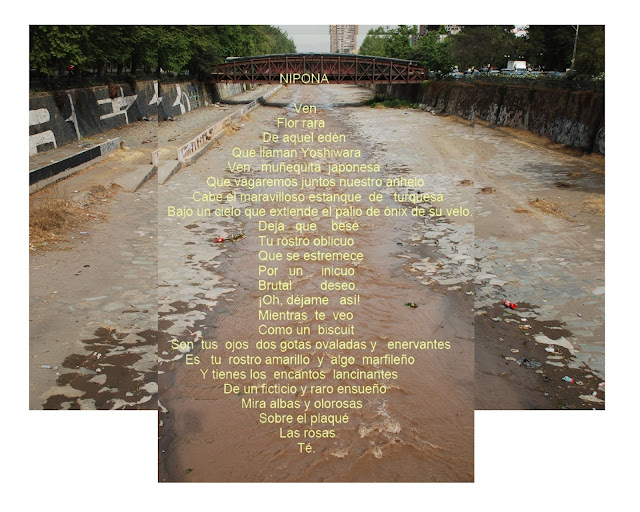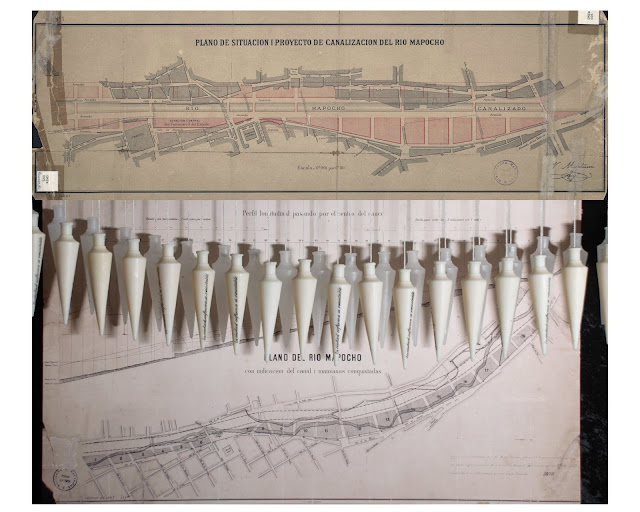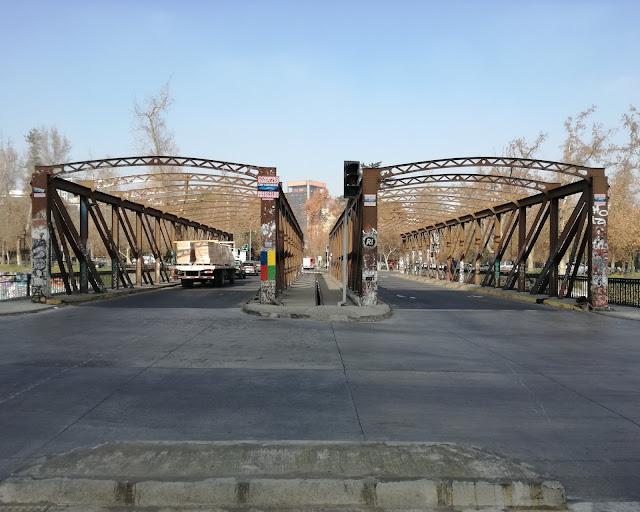Pious Poet
Historical/cultural context (01/03/20)
Puente Vicente Huidobro was one of 6 metal bridges made for the canalized Mapocho by the French engineering company Schneider-Creusot (a steel mill and arms manufacturer). Vicente Huidobro Garcia was a Chilean avant guard poet and writer who collaborated with Apollinaire in France in the founding of a literary movement called Creationsim. The bridge was better known, from at least the early 20th C, as Puente Pio Nono, named after Pope Pius IX, but it is not where it used to be. It was built, along with 5 others, in France and shipped to Santiago and assemble on site. Its double curved arches, that mirror the canal’s causeway, are known in its original position and the public imaginary through a post-impressionist painting from the 1920s and photographs (Image 9) including those of the 1980s flooding canal that reached and breached its banks and the base of this bridge with waves crashing over both. Until 1986 this poetic crossing connected the Bohemian barrio of Bellavista, where Pablo Neruda lived, with the demographic centre of Santiago, Plaza Italia, that was a gift from Italy for the centenary of Chile’s Independence. Plaza Italia became Plaza Baquedano in 1928, named after the Commander in Chief of the Army in the Pacific War, and only became the centre for all public demonstrations and re- reimagined as Plaza Italia during the “No” Campaign for the Plebiscite of 1988. Now, in the global imaginary, the 1.2 million demonstrators of October 25, 2019 filled Plaza Italia overflowing like the Mapocho across Pio Nono (Image 10). Plaza Baquedano was renamed by the protesters Plaza of Dignity and most of the railings and lights of the Pio Nono destroyed soon after. Puente Vicente Huidobro cannot be crossed, it is a theatre, the only performance space in the world suspended over a river, that is but a trickle most of the year, and it is located 300 metres to the west of the new/old Pio Nono. (Image 11). Huidobro’s replacement Pio Nono is a heritage replica of millennial 20C urban design and is known only by this playful name; the words in English would translate as Popa (grandfather) Pope. Puente Huidobro, the bridge, is never called by its name, it is Puente Teatro.
Puente Vicente Huidobro was one of 6 metal bridges made for the canalized Mapocho by the French engineering company Schneider-Creusot (a steel mill and arms manufacturer). Vicente Huidobro Garcia was a Chilean avant guard poet and writer who collaborated with Apollinaire in France in the founding of a literary movement called Creationsim. The bridge was better known, from at least the early 20th C, as Puente Pio Nono, named after Pope Pius IX, but it is not where it used to be. It was built, along with 5 others, in France and shipped to Santiago and assemble on site. Its double curved arches, that mirror the canal’s causeway, are known in its original position and the public imaginary through a post-impressionist painting from the 1920s and photographs (Image 9) including those of the 1980s flooding canal that reached and breached its banks and the base of this bridge with waves crashing over both. Until 1986 this poetic crossing connected the Bohemian barrio of Bellavista, where Pablo Neruda lived, with the demographic centre of Santiago, Plaza Italia, that was a gift from Italy for the centenary of Chile’s Independence. Plaza Italia became Plaza Baquedano in 1928, named after the Commander in Chief of the Army in the Pacific War, and only became the centre for all public demonstrations and re- reimagined as Plaza Italia during the “No” Campaign for the Plebiscite of 1988. Now, in the global imaginary, the 1.2 million demonstrators of October 25, 2019 filled Plaza Italia overflowing like the Mapocho across Pio Nono (Image 10). Plaza Baquedano was renamed by the protesters Plaza of Dignity and most of the railings and lights of the Pio Nono destroyed soon after. Puente Vicente Huidobro cannot be crossed, it is a theatre, the only performance space in the world suspended over a river, that is but a trickle most of the year, and it is located 300 metres to the west of the new/old Pio Nono. (Image 11). Huidobro’s replacement Pio Nono is a heritage replica of millennial 20C urban design and is known only by this playful name; the words in English would translate as Popa (grandfather) Pope. Puente Huidobro, the bridge, is never called by its name, it is Puente Teatro.
Image: The intervention in this
bridge/site/replacement/movement will be based in the form of one of Huidobro’s
concrete poems and the metaphor of communication - of language and physical
movement - that bridges borders – natural and humanmade.
Image above. Puente Vicente Huidobro in its current location with the concrete poem, Nippon, by Vicente Huidobro, pointing to both its current and original location. This collage is a way of investigating the bridge as an object, crossing as location, site, dwelling and place and the idea of forgetting and false memory.
Image above. Puente Vicente Huidobro in its current location with the concrete poem, Nippon, by Vicente Huidobro, pointing to both its current and original location. This collage is a way of investigating the bridge as an object, crossing as location, site, dwelling and place and the idea of forgetting and false memory.
 |
| Puente Vicente Huidobro, better known as Pio nono, in its original location during the flooding and overflowing of the Mopocho River in 1986 |
 |
| Puente Vicente Huidobro, better known as Pio nono, in its original location, viewed from its current location. |





Comments
Post a Comment